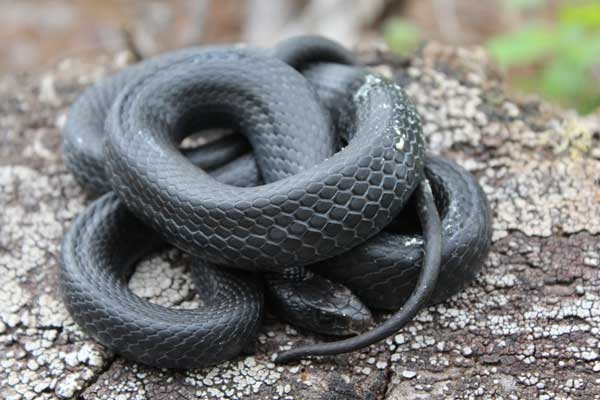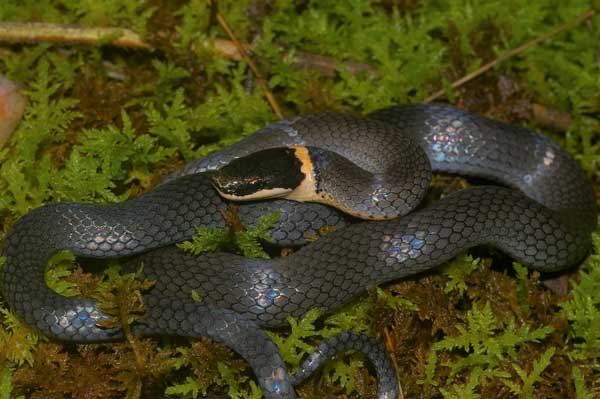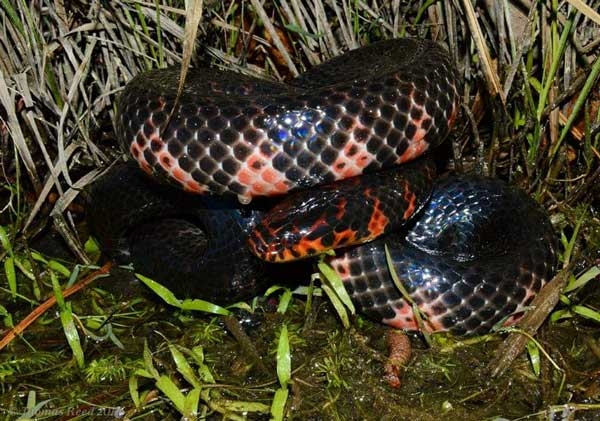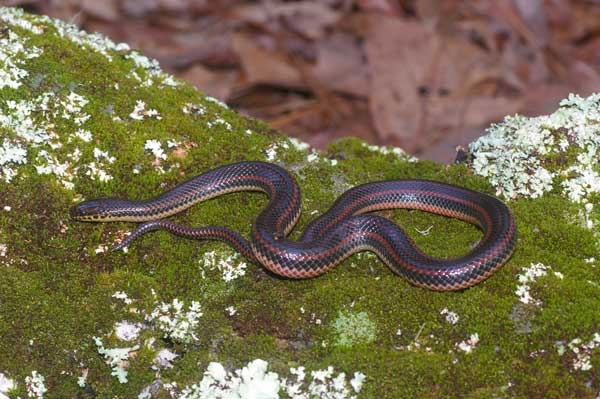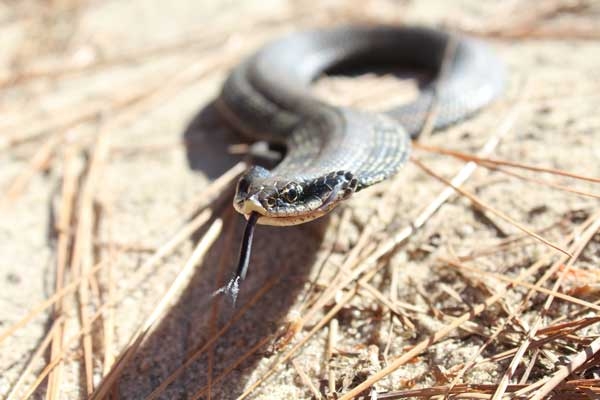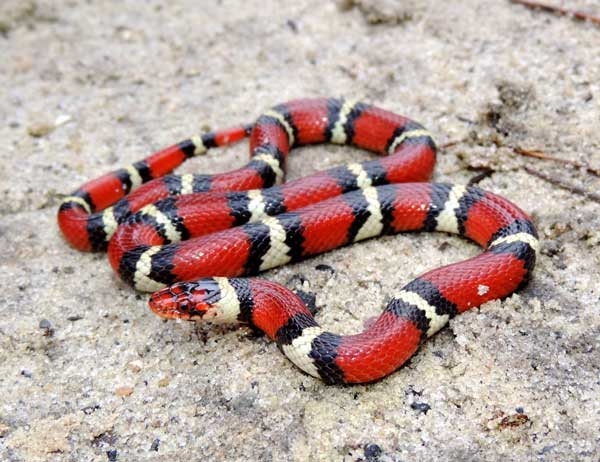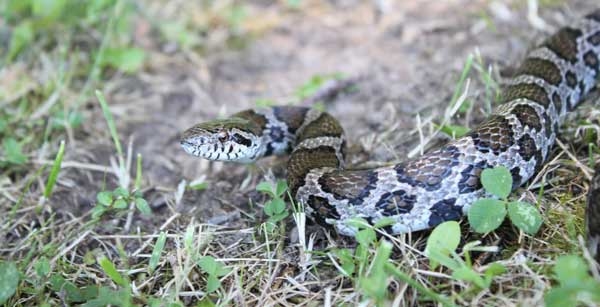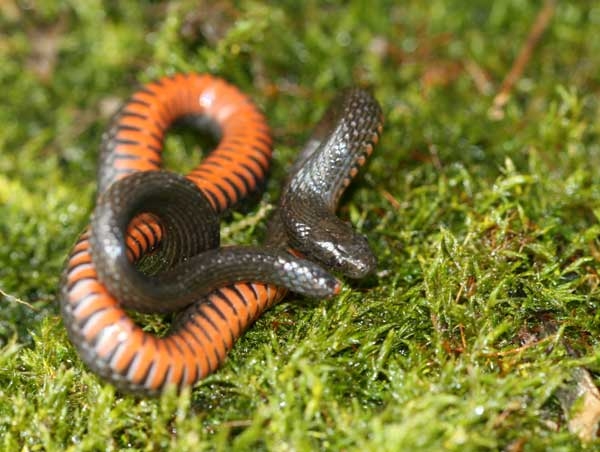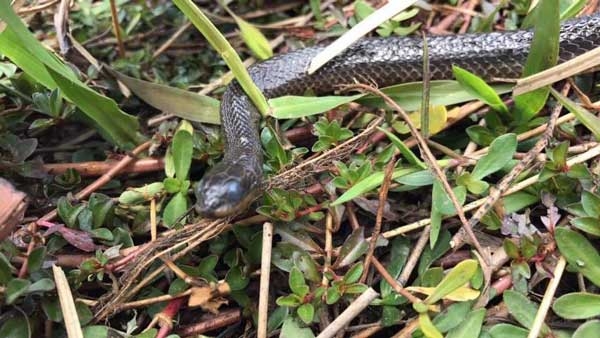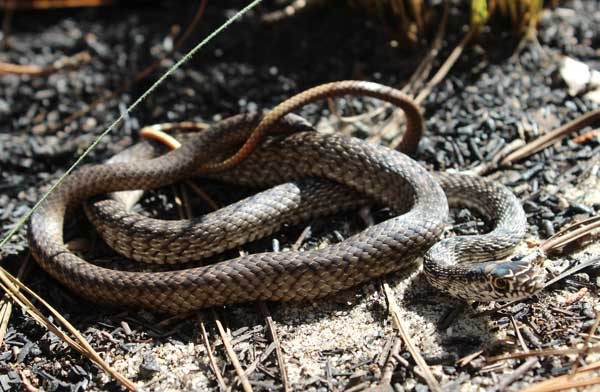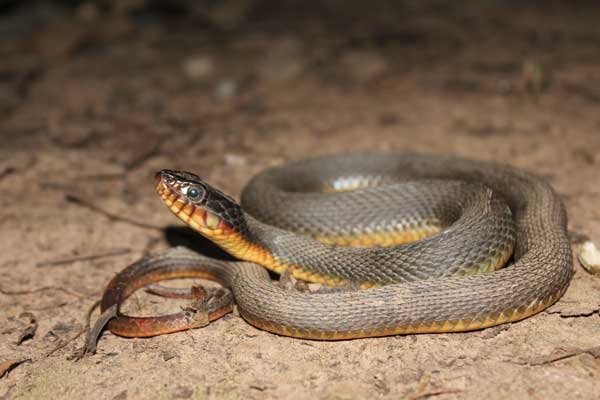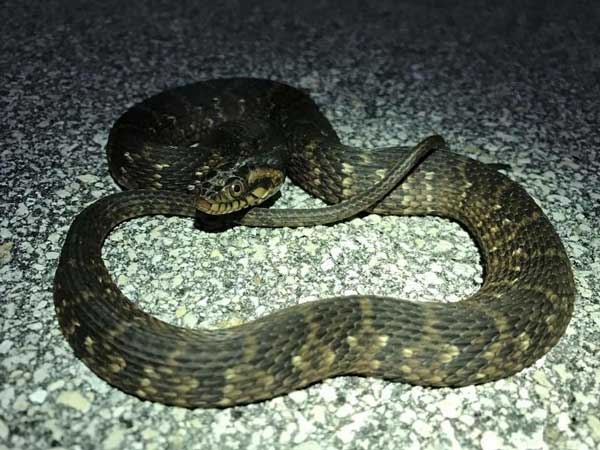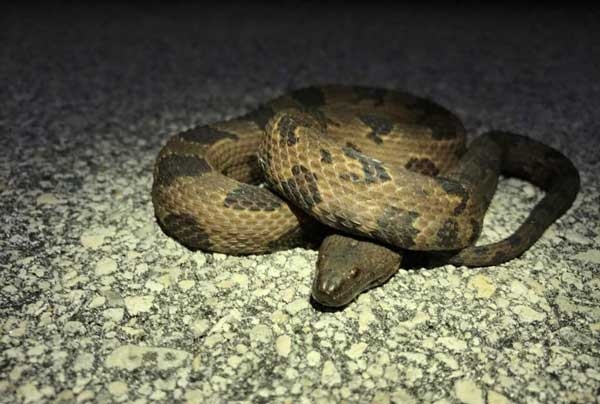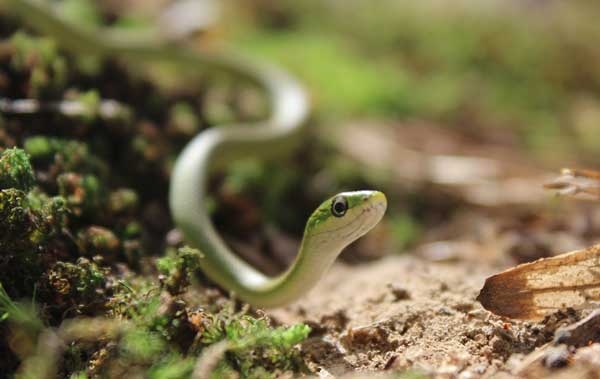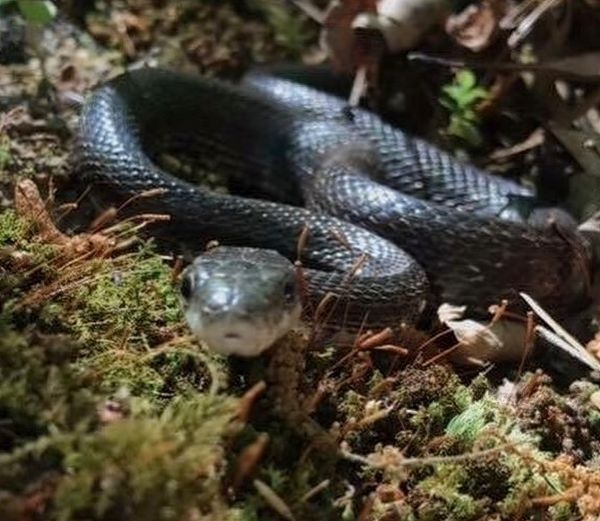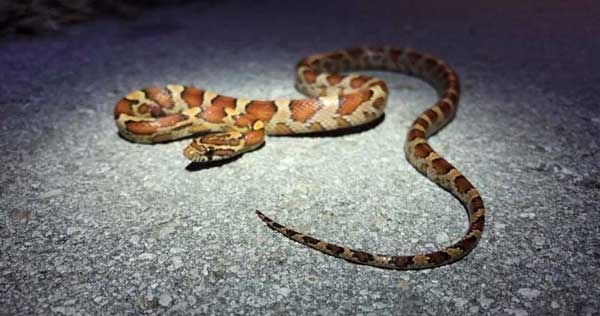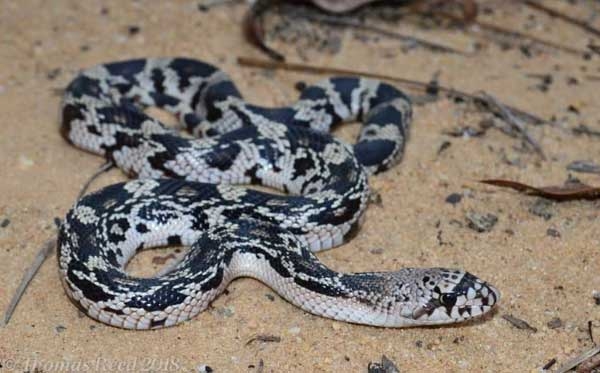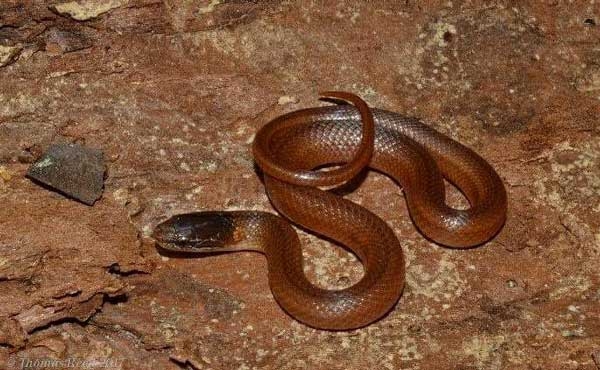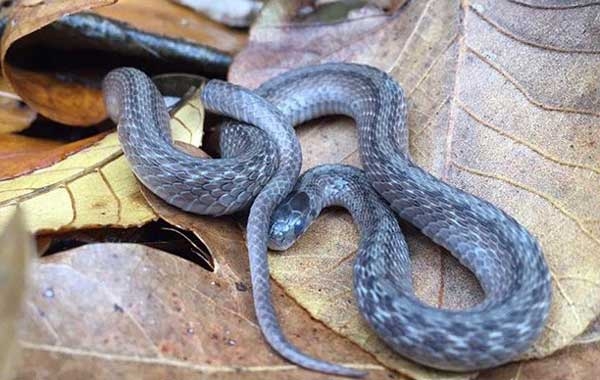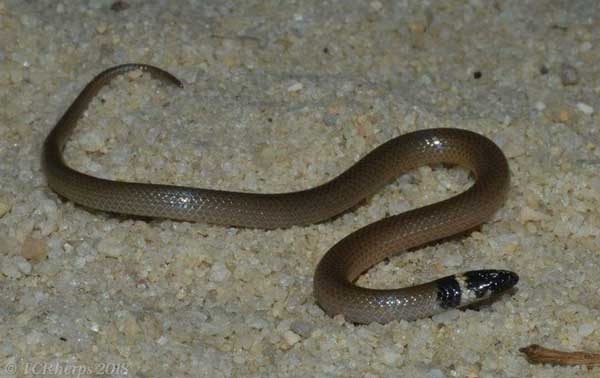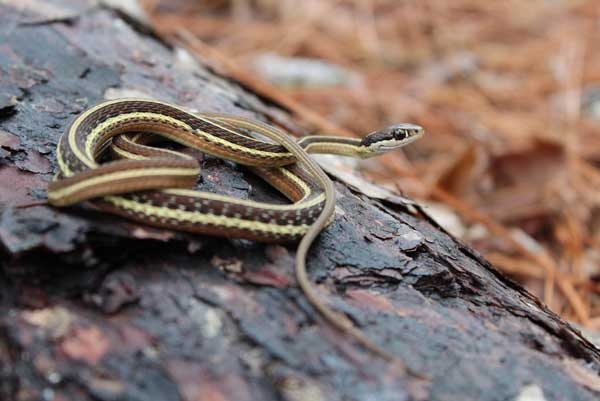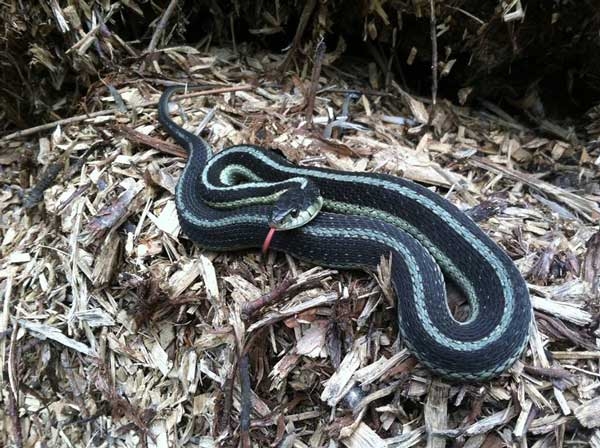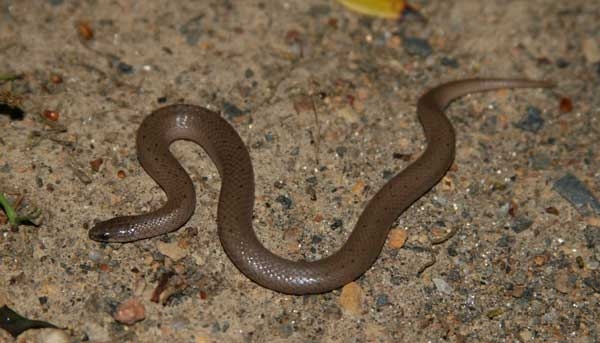Contents
Family Colubridae
Eastern Worm Snake—Harmless
Scarlet Snake—Harmless
Black Racer—Harmless
Ring-Necked Snake—Harmless
Mud Snake—Harmless
Rainbow Snake—Harmless
Rough Earth Snake—Harmless
Eastern Hognose Snake—Harmless
Southern Hognose Snake—Harmless
Scarlet Kingsnake—Harmless
Eastern Kingsnake—Harmless
Mole Kingsnake—Harmless
Eastern Milk Snake—Harmless
Black Swamp Snake—Harmless
Glossy Crayfish Snake—Harmless
Eastern Coachwhip—Harmless
Red-Bellied Water Snake—Harmless
Banded Water Snake—Harmless
Northern Water Snake—Harmless
Brown Water Snake—Harmless
Rough Green Snake—Harmless
Eastern Rat Snake—Harmless
Corn Snake—Harmless
Pine Snake—Harmless
Queen Snake—Harmless
Pine Woods Snake—Harmless
Dekay’s Brown Snake—Harmless
Red-Bellied Snake—Harmless
Southeastern Crowned Snake—Harmless
Eastern Ribbon Snake—Harmless
Eastern Garter Snake—Harmless
Smooth Earth Snake—Harmless
Eastern Worm Snake
Harmless
Eastern worm snakes occur statewide and typically reach 13 inches in length. Eastern worm snakes have smooth scales and are typically glossy brown dorsally (on top) and glossy pink ventrally (underneath). They are egg-laying, highly fossorial (located underground), and are usually only encountered on the surface at night. Eastern worm snakes have a small spine on the end of their tail that helps restrain prey. They primarily eat earthworms and soft-bodied invertebrates. When handled, they may try to burrow into your hand or poke you with their spine. However, they typically do not bite, and their spine is harmless.
Scarlet Snake
Harmless
Scarlet snakes occur throughout much of the coastal plain and piedmont of North Carolina, but they are rare to absent in the mountains. They are most common in the southern coastal plain and sandhills. The scarlet snake reaches 26 inches in length when fully grown. They have smooth scales with a white base color overlain with red saddles edged by thin black bands. They may be confused with the eastern coral snake or the scarlet kingsnake but can be easily distinguished. The scarlet snake does not have bands that completely encircle the body. In addition, the scarlet snake has a red snout and a black-on-red color scheme interspersed with white, compared to the eastern coral snake, which has a black snout and thick red and black bands interspersed with narrow yellow bands. The scarlet kingsnake has the same color scheme as the scarlet snake but has bands that completely encircle the body and a less pointed snout. Scarlet snakes are egg-laying and spend most of the day underground or in rotting logs, emerging on warm nights. Scarlet snakes primarily eat small reptile eggs but will occasionally eat smaller snakes and lizards. They rarely bite when handled.
Black Racer
Harmless
Black racers typically reach 66 inches in length and occur statewide. Relatively common, the black racer has smooth scales, and is entirely black dorsally and black or dark gray ventrally as an adult. Some individuals may have varying levels of white on the lip or neck. As juveniles, they have a gray base color with light brown splotches dorsally. The black racer may be confused with an eastern rat snake. However, the eastern rat snake has weakly keeled scales and a checkerboard pattern ventrally. In addition, the eastern rat snake has a flatter head with smaller eyes featuring small, distinct black pupils. As juveniles, black racers may be confused with juvenile eastern rat snakes, northern water snakes, and eastern milk snakes. Juvenile eastern rat snakes can be distinguished using the same features common to the adults. Northern water snakes (Nerodia sipedon) have strongly keeled scales and a different banding pattern. The eastern milk snake has smaller eyes and a different head pattern, with a black line behind the eye. Black racers are active only during the day and will hide at night. They are egg-laying and prey on insects, amphibians, birds, other reptiles, mammals, and eggs. Despite their scientific name, they are not constrictors and will consume prey live. When approached, black racers usually try to escape and are extremely fast, as their name implies. If cornered, the black racer may vibrate its tail, strike repeatedly, and emit a foul-smelling musk from its cloaca. The bite of a racer is likely to break the skin and may leave small scratches, but these are superficial wounds and are not dangerous.
Ring-Necked Snake
Harmless
Ring-necked snakes reach 20 inches in length and occur statewide. The ring-necked snake is black or slate gray on top and yellow or orange ventrally with a complete or nearly complete yellow or orange ring around the neck. The scales are smooth. Ring-necked snakes are primarily active at night and hide during the day. They are egg-laying and feed primarily on salamanders and earthworms but will eat small frogs, lizards, and other snakes. When handled, ring-necked snakes will thrash and emit a foul-smelling musk, but rarely bite.
Mud Snake
Harmless
Mud snakes reach a maximum length of 73 inches and occur in the coastal plain and lower piedmont of North Carolina. They are black on top with iridescent, smooth scales. Ventrally, mud snakes can be black with red, orange, or pink markings and rarely can be black and white with yellow around the head. The ventral color extends up the sides of the snake in a triangular-shaped marking. Mud snakes are highly aquatic and feed primarily on amphiumas and sirens, two types of aquatic salamanders, but will eat other amphibians. Mud snakes are egg-laying and possess a pointed tail tip similar to that of the eastern worm snake. When cornered, mud snakes usually thrash and poke their captors with their harmless tail tips. Mud snakes rarely bite.
Rainbow Snake
Harmless
Rainbow snakes reach 66 inches in length and have a blue or black base color dorsally with three red longitudinal stripes. These highly aquatic snakes are active at night and occur primarily along the coastal plain of North Carolina but are rarely seen. The scales of the rainbow snake are smooth and iridescent. Ventrally, the scales are red or pink with two to three rows of black spots. These egg-laying snakes feed on amphibians and American eels. Also, rainbow snakes possess pointed tail tips like those of the mud snake and eastern worm snake. When cornered, rainbow snakes press their harmless tail tips into the captors’ hands but rarely bite.
Rough Earth Snake
Harmless
Rough earth snakes reach a length of 13 inches and occur throughout the eastern piedmont and the coastal plain. Dorsally, the scales are keeled and brown or grayish brown. Usually, they have a pale band across the top of their heads that resembles a collar. Ventrally, they are glossy white or greenish white. Rough earth snakes are highly fossorial and spend the majority of their time underground or under cover objects. They are live-bearing and feed primarily on earthworms. If cornered, rough earth snakes may squirm and emit a foul-smelling substance called musk, but are not known to bite.
Eastern Hognose Snake
Harmless
Eastern hognose snakes reach 47 inches in length. They occur throughout North Carolina and have highly variable color patterns. In North Carolina, common color variations include black or gray, while others have a mottled pattern of gray, brown, red, yellow, or orange markings with black spotting on the dorsum. The surface underneath is white toward the head but darkens farther down the body, turning to black near the cloaca. Ventrally, the tail is usually lighter than the belly. Eastern hognose snakes have keeled scales and upturned snouts. Eastern hognose snakes may be easily confused with southern hognose snakes; however, southern hognose snakes have a more upturned snout and a more uniform ventral color. Southern hognose snakes do not have an all-black form. Eastern hognose snakes are most common in the coastal plain and tend to be associated with sandy or loamy soil. They are active strictly during the day and feed primarily on toads but will eat other amphibians. Both eastern hognose snakes and southern hognose snakes are egg-laying. When encountered, eastern hognose snakes will perform a dazzling array of theatrics. First, they will rear up, flatten their necks, and hiss. They will occasionally bluff strike but rarely actually bite. If further threatened, they may thrash, hiss, emit a foul-smelling substance called musk, regurgitate, and eventually play dead, rolling onto their backs and sticking their tongues out. If righted, they may immediately roll onto their backs.
Southern Hognose Snake
Harmless
(Heterodon simus)—Threatened in North Carolina
The southern hognose snake is smaller than the eastern hognose snake and reaches 29 inches in length. The southern hognose occurs only in the southeastern portion of the sandhills and coastal plain. On top, they have a gray, light brown, or tan base color with dark spots. Ventrally, they are whitish with mottled gray or brown. The scales are keeled. Southern hognose snakes may be confused with eastern hognose snakes but have a much more upturned snout and a more uniform ventral color. Southern hognose snakes are associated with coarse sandy or loamy soils and are active during the day. They are excellent burrowers and spend most of their time underground. They are egg-laying and feed primarily on spadefoot toads but will eat other amphibians and reptiles. When encountered, the southern hognose snake will flatten its head and puff out its neck and may play dead, similar to the eastern hognose, but the southern hognose snake tends to be less dramatic. Southern hognose snakes may emit a foul-smelling substance called musk, but they rarely bite.
Scarlet Kingsnake
Harmless
The scarlet kingsnake is a close relative of the eastern milk snake and can reach 27 inches in length. It occurs primarily in the coastal plain but also in small populations in the piedmont and mountains. The scarlet kingsnake has smooth scales and red, black, and white or yellow bands that usually encircle the body or extend to the ventral surface. The harmless scarlet kingsnake is considered a mimic of the venomous eastern coral snake, but it can be distinguished by its color pattern in the eastern United States. (The color pattern does not easily distinguish the species in Central and South America.) The eastern coral snake has red bands that touch the yellow bands and has a black snout. The scarlet kingsnake has red bands that touch only the black bands, and it has a red snout. The common saying, “Red touches black, you’re OK Jack; red touches yellow, you’re a dead fellow” is often used to remember this difference. Also, the scarlet kingsnake may be confused with the harmless scarlet snake. However, the bands on the scarlet snake do not completely encircle the body, and the snout is more pointed. Scarlet kingsnakes are active at night and spend most of their time hiding. They are egg-laying and feed primarily on skinks but will eat small snakes, other lizards, and small mammals. When handled, the scarlet kingsnake might bite and emit a foul-smelling substance called musk.
Eastern Kingsnake
Harmless
Eastern kingsnakes can reach a length of 69 inches. They occur across most of North Carolina, most commonly in the coastal plain, but are absent from much of the mountains. Eastern kingsnakes are black dorsally with white or cream chain-like markings. The dorsal scales are smooth and shiny. Eastern kingsnakes may be confused with eastern rat snakes, especially when the adult eastern rat snake maintains slight banding, but they can be readily distinguished by the smooth scales. Ventrally, they have irregularly spaced black-and-white patches. On the Outer Banks, this species has a more brownish base color and more speckling within each dark segment, though this pattern can occasionally be seen elsewhere. The eastern kingsnake is egg-laying and feeds on turtle eggs, lizards, birds, small mammals, and other snakes, including venomous snakes. Eastern kingsnakes sometimes bite and emit a foul-smelling substance called musk if cornered. But they are harmless and will usually calm down soon after being captured.
Mole Kingsnake
Harmless
Mole kingsnakes can reach 46 inches in length. They occur throughout most of North Carolina except for most of the mountains and the northeastern coastal plain. Mole kingsnakes have smooth scales; dorsally, they have a light brown, red, or tan base color with darker reddish-brown diamond-like blotches. Underneath, they are light yellow or cream, sometimes with a checkerboard pattern of tans and browns. Juveniles are often brighter than adults. As they age, the pattern may begin to fade to brown or tan in some adults. This species may be easily confused with the eastern milk snake and the corn snake, but it can be distinguished by the size, shape, and color of the blotches on the back. The eastern milk snake has wider, more rounded blotches, whereas the mole kingsnake has more elliptical blotches. Also, the eastern milk snake has a row of brown, circular blotches on the side. Corn snakes are more vibrant, and their markings are wider and more circular than the markings of the mole kingsnake, which are thinner and elliptical. The mole kingsnake is primarily fossorial but also spends some time aboveground under objects. Active day or night, they feed on small mammals, lizards, and other snakes. Mole kingsnakes are egg-laying. When encountered, they may vibrate their tail and attempt to bite.
Eastern Milk Snake
Harmless
Eastern milk snakes can reach a length of 45 inches and occur primarily in the mountains of North Carolina. Dorsally, this snake is smooth and has a light brown or tan base color with wide brown, red, or gray blotches outlined with black. This snake has small circular markings on the sides of its body that are the same color as the dorsal blotches, and it has a Y-, U-, or V-shaped marking on the neck. Ventrally, they are checkered black and white. The eastern milk snake may be confused with the mole kingsnake or juvenile eastern rat snake. The eastern milk snake has wider, more rounded blotches, whereas the mole kingsnake has more elliptical blotches. Also, the eastern milk snake has a row of brown, circular blotches on the side. Eastern milk snakes can be distinguished from juvenile eastern rat snakes by the smooth dorsal scales. Eastern milk snakes spend much of their time under cover objects and may be active during the day or night. They are egg-laying and feed on small snakes, lizards, and small mammals. Eastern milk snakes are generally nonaggressive when handled but might bite.
Black Swamp Snake
Harmless
(Liodytes pygaea)—Special Concern in North Carolina
Black swamp snakes can reach 19 inches in length and occur in the outer coastal plain from Bodie Island southward. Dorsally, the black swamp snake has smooth scales and is glossy black. The ventral surface is red or orange with a jagged edge. Black swamp snakes are occasionally active at night but are rarely encountered. This is likely due to a combination of their rarity coupled with their habit of spending most of their time in aquatic vegetation or under vegetation or moss near the edge of slow-moving water. They are live-bearing and feed primarily on worms, leeches, fish, and amphibians. When cornered, they rarely bite.
Glossy Crayfish Snake
Harmless
Glossy crayfish snakes can reach lengths of 31 inches and occur in portions of the southern and outer coastal plain. The glossy crayfish snake has keeled scales and a glossy appearance. Dorsally, they are solid brown or dark olive. The lips are dark yellow-brown. Ventrally, they have a yellowish base with two rows of crescent-shaped spots. Glossy crayfish snakes are most commonly seen at night and spend most of their time in or around fresh water. They are live-bearers and feed primarily on crayfish but will also eat other aquatic invertebrates and some small vertebrates. If cornered, they will flatten their heads and may bite and emit a foul-smelling substance called musk.
Eastern Coachwhip
Harmless
The eastern coachwhip is the longest snake in North Carolina and can reach lengths of 94 inches. This snake occurs primarily in the southeastern coastal plain and sandhills. As an adult, the eastern coachwhip is dark brown or black dorsally on its head and anterior third of the body, which fades to light brown with a braided, whip-like appearance. As juveniles, eastern coachwhips have dark, wavy cross bands covering their dorsal side; underneath, they are light with two rows of black or brown spots toward the anterior end. In addition, juveniles have white outlines on their heads and on the back of their necks. The scales are smooth. Eastern coachwhips are egg-laying and feed on lizards, snakes, birds, bird eggs, and small mammals. These slender snakes are one of the fastest, if not the fastest, snake species in North Carolina and will rapidly flee or seek refuge when encountered. However, when cornered, they will vibrate their tail, strike, and may even play dead. Also, they may continuously bite and strike at the face.
Red-Bellied Water Snake
Harmless
Red-bellied water snakes can reach 60 inches in length and occur in the eastern half of North Carolina. On top, adults are reddish brown to dark brown and are keeled. Ventrally, this species is orange or reddish with a small amount of white on the chin. Juveniles have a pinkish to light-brown base color dorsally with dark-brown cross bands. Ventrally, juveniles are light orange. Juveniles may easily be confused with northern water snakes and banded water snakes; however, northern water snakes have brown or reddish, half-moon-shaped spots along their ventral surface. Banded water snakes have unbroken bands the length of the body and a black or brown line extending from the eye to the back of the upper jaw. Red-bellied water snakes are live-bearing and feed on fish, toads, and frogs. Red-bellied water snakes can be active day or night. Although they usually are located near water, they are occasionally located far from water. When encountered, these water snakes will usually flee; but if they are cornered, they will defend themselves by continuously biting.
Banded Water Snake
Harmless
Banded water snakes can reach lengths of 55 inches and occur in the coastal plain and sandhills of North Carolina. This species has keeled scales and is highly variable in base color. Dorsally, it can range from light brown to reddish orange and black with dark-brown or reddish unbroken cross bands and a dark line behind each eye running to the corner of the jaw. Sometimes this species can be so dark that the patterns are indistinguishable. Ventrally, this species has squarish or triangular markings. The patterns on juveniles are usually darker, with a high contrast. This species can be very difficult to differentiate from northern water snakes and will hybridize where their ranges overlap. Northern water snakes usually have broken bands and lack the dark lines behind the eyes. Juvenile banded water snakes may be confused with northern water snakes but can be differentiated by the ventral patterns. Banded water snakes may be active day or night and tend to be located near fresh water. They are live-bearing and feed on fish and amphibians. Like the other water snakes in North Carolina, banded water snakes will usually flee when encountered. But when cornered, they will readily and repeatedly bite and emit a foul-smelling substance called musk.
Northern Water Snake
Harmless
Northern water snakes can reach a length of 50 inches and occur throughout most of the mountains, piedmont, the northeastern coastal plain, and the Outer Banks. This species is absent from much of the southern coastal plain and sandhills. They are highly variable in appearance and have keeled dorsal scales. Its base color ranges from brown to gray to reddish. Dorsally, they have dark-brown or black cross banding near the head that has broken bands or alternating blotches for the posterior two thirds of the body. Ventrally, northern water snakes are yellowish with brown or reddish, half-moon-shaped spots. Juveniles usually have much more prominent patterns and vivid coloration than adults. In populations on the Outer Banks and near brackish water, individuals have a dark-brown base color with black cross bands; these individuals are considered a subspecies known as the Carolina water snake (Nerodia sipedon williamengelsi), which is listed as a species of special concern in North Carolina. Northern water snakes can be easily confused with banded water snakes and may hybridize in areas where their ranges overlap. Also, this species may be confused with juvenile red-bellied water snakes but can be distinguished by the presence of a belly pattern. Northern water snakes may be active day or night and commonly bask on tree limbs extending over water or on debris in or near the water. Northern water snakes are live-bearing and feed on fish and amphibians. When encountered, these snakes will usually flee, but if cornered, will defensively bite and emit a foul-smelling substance called musk.
Brown Water Snake
Harmless
The largest of the water snakes in North Carolina, the brown water snake can reach lengths of 64 inches and has a heavy body, flat head, and protruding eyes. Brown water snakes occur in the coastal plain, southern piedmont, and sandhills. Their scales are dorsally keeled. Brown water snakes have a brown base color with dark-brown or black, squarish blotches on the back and sides. Ventrally, they are yellow with mottled brown or black. Brown water snakes can be active day or night, and they are aquatic (spend time in water) and arboreal (spend time in trees). They are live-bearing and feed on fish, especially catfish. If cornered, they will usually bite and emit a foul-smelling substance called musk. While lying on a tree limb over water, the brown water snake occasionally will get spooked and unintentionally fall into boats passing by; however, they are not venomous and will retreat if given access to the water.
Rough Green Snake
Harmless
Rough green snakes can reach lengths of 36 inches. They occur throughout North Carolina except for the higher elevations in the mountains. Dorsally, the scales are keeled and entirely green. Underneath, they are yellow or greenish yellow. Newly hatched snakes are gray or grayish green on top and white ventrally. Dead rough green snakes will fade to blue when left exposed to the sun. They are active during the day and are arboreal, using small trees, shrubs, vines, and other foliage. They are egg-layers and feed on spiders, grasshoppers, crickets, caterpillars, small snails, and other soft-bodied invertebrates. Rough green snakes can be very difficult to spot. If cornered, they will gape their mouths but typically will not bite.
Eastern Rat Snake
Harmless
Eastern rat snakes are one of the largest snakes in North Carolina, reaching up to 85 inches long. They occur statewide. Featuring weakly keeled scales, the adult is dorsally black with a white chin. Underneath, the front half of the body tends to be lighter and checkered, while the back half tends to be darker. Juveniles have a light gray or brown base color with darker brown or gray blotches. Adults may easily be confused with black racers, but can be distinguished by the presence of keeled scales as well as the shape of the head and the size of the eyes. The eastern rat snake has a flatter head with smaller eyes featuring small, distinct black pupils compared to black racers. Juveniles may be confused with juvenile black racers and eastern milk snakes. However, eastern rat snakes have keeled scales, unlike the black racer and the eastern milk snake. Excellent climbers, eastern rat snakes are commonly encountered in trees and bushes. Eastern rat snakes are egg-laying and primarily eat small rodents, birds, and amphibians. When encountered, eastern rat snakes may try to escape or may remain motionless and then begin to vibrate their tails. If cornered, eastern rat snakes may bite and emit musk but are often quick to relax.
Corn Snake
Harmless
Corn snakes reach 72 inches in length and occur statewide. Corn snakes have a glossy red, orange, gray, or brown base color dorsally with reddish-brown markings outlined with black. Underneath, corn snakes have a checkered black-and-white pattern. Corn snakes may be easily confused with many snake species. They are active both day and night depending on the temperature. Corn snakes are excellent climbers and will eat birds, bird eggs, frogs, lizards, and small mammals. Corn snakes are egg-laying. They vary in temperament and may or may not bite when first handled. They typically emit musk but may relax quickly in some instances.
Pine Snake
Harmless
(Pituophis melanoleucus)—Threatened in North Carolina
Pine snakes can reach a length of 72 inches. They occur primarily in the sandhills, but small populations also persist in the extreme southeastern coastal plain and in the far southwestern mountains. Pine snakes have keeled scales, exhibiting a white or yellow base color with black or brown blotches. The blotches are less distinct toward the head but become more distinct toward the posterior of the body. Pine snakes are primarily diurnal (active during the day) and fossorial. They are egg-layers and feed primarily on small mammals, birds, and bird eggs. If cornered, they may vibrate their tails, hiss, and attempt to bite.
Queen Snake
Harmless
Queen snakes can reach a length of 34 inches and occur in the piedmont and mountains of North Carolina. Dorsally, they have keeled scales and are dark brown. Occasionally, queen snakes will have three obscure dorsal stripes. Queen snakes have yellow lines on both sides of their bodies and yellow lips. Ventrally, they are yellow with brown or tan striping. Generally, juveniles have more prominent patterning than adults. Queen snakes are primarily active during the day and are usually located in or near water. They tend to bask on tree limbs over the water and may seek shelter under rocks or debris near the water’s edge. Queen snakes are live-bearing and feed primarily on freshly molted crayfish. When cornered, they may bite.
Pine Woods Snake
Harmless
Pine woods snakes can reach 15 inches in length and occur in the southeastern coastal plain, with separate populations in the sandhills and on Roanoke and Bodie islands on the Outer Banks. Dorsally, they have smooth scales and are an iridescent golden brown or reddish brown. The head is a darker shade of the base color, and a light-brown line extends behind each eye. Ventrally, they are glossy yellow or white. They are primarily active at night and fossorial. Pine woods snakes are egg-laying and feed primarily on lizards and frogs. Although they are harmless to humans, they do use a weak venom to paralyze prey. When cornered, pine woods snakes may emit a foul-smelling substance called musk, but they are not known to bite.
Dekay’s Brown Snake
Harmless
Dekay’s brown snakes can reach 18 inches in length. They occur throughout North Carolina except for portions of the mountains. Dorsally, the scales are keeled and brown, gray, or reddish brown. This species usually has a pale stripe down the center of the back and paired dark-brown or black blotches that run the length of the body. Some individuals may have a half-collar behind the head; especially in juveniles, that half-collar may lack other patterning. Ventrally, this species is white or pinkish and may have small black dots down the sides. They are primarily active at night and spend much of their time under cover objects. Dekay’s brown snakes are live-bearers and feed primarily on slugs and earthworms. When cornered, Dekay’s brown snakes usually do not bite, but may emit a foul-smelling substance called musk and flatten their heads.
Red-Bellied Snake
Harmless
Red-bellied snakes can reach 12 inches in length and occur throughout North Carolina. Dorsally, they have keeled scales and range from light grayish and black to tan, brown, or reddish. Red-bellied snakes usually have a white blotch on the last lip scale, three yellowish or orange blotches on the neck, and a white or gray chin. A light stripe may occur down the mid-dorsum, edged with black; some of the scales may have small white spots. Ventrally, they are red or orange and usually have gray or black markings at the edges of the scales. Red-bellied snakes are primarily active at night but may sometimes be active during the day. They are most common in upland areas and shelter under rocks, logs, or other ground debris. Red-bellied snakes are live-bearing and feed primarily on slugs and snails. When cornered, they may flatten out and emit a foul-smelling substance called musk, but they are not known to bite. Also, red-bellied snakes have a curious behavior of lip-curling when handled or threatened.
Southeastern Crowned Snake
Harmless
Southeastern crowned snakes can reach 12 inches when fully grown. They are most common in the southeastern coastal plain and sandhills, but they also occur over much of the piedmont and in portions of the southeastern mountains and foothills of North Carolina. Dorsally, the scales are smooth and tan or reddish brown. Southeastern crowned snakes have a black or dark-brown head, followed by a cream-colored ring and subsequent dark collar. Ventrally, they are white or yellow. Southeastern crowned snakes are active at night and spend most of the day underground or under cover objects. These snakes are egg-laying and feed primarily on centipedes but will eat other soft-bodied arthropods. When cornered, these snakes are not known to bite. Though harmless to humans, southeastern crowned snakes are rear-fanged and do use a weak venom to subdue prey.
Eastern Ribbon Snake
Harmless
Eastern ribbon snakes can reach a length of 38 inches. They are most common in the coastal plain, but also occur throughout much of the piedmont and in portions of the mountains. On top, they have keeled scales and a dark-brown or black base color with three yellow stripes running the length of the body. Ventrally, they are white or pale yellow. Eastern ribbon snakes have a vertical white stripe in front of their eyes, a marking that helps to distinguish them from the closely related eastern garter snake. Eastern ribbon snakes are most active during the day but may be active at night. They are semiaquatic and are usually associated with wetlands. Eastern ribbon snakes are live-bearing and feed on fish and amphibians. When cornered, they usually thrash and emit a foul-smelling substance called musk and occasionally bite.
Eastern Garter Snake
Harmless
Eastern garter snakes can reach a length of 42 inches and occur throughout North Carolina. Dorsally, they have keeled scales, and their base color ranges from green and blue to brown and red. They usually have a light stripe down the center of the dorsum coupled with two less-defined stripes on either side of the body. Some individuals lack the stripe and instead have spots reminiscent of a checkered pattern. Eastern garter snakes are active day and night. They tend to be located in moist environments and may be under rocks, logs, or other cover objects. They are live-bearing and feed mostly on earthworms, fish, and amphibians. When cornered, they may flatten their bodies, emit a foul-smelling substance called musk, and bite. Harmless to humans, eastern garter snakes do use their mildly toxic saliva to capture prey.
Smooth Earth Snake
Harmless
Smooth earth snakes reach an adult length of 13 inches. They range throughout much of the piedmont, southern mountains, and coastal plain of North Carolina. Dorsally, they have smooth scales and are gray, brown, or reddish brown with scattered black spots. Ventrally, they are creamy white. This species may be easily confused with the rough earth snake but can be distinguished by the lack of keeled scales. They are primarily active at night and are occasionally encountered on roads. Also, they can be located under objects on the ground. The smooth earth snake is live-bearing and feeds primarily on earthworms. When cornered, they may emit a foul-smelling substance called musk, but are not known to bite.
Publication date: Aug. 21, 2019
Reviewed/Revised: July 15, 2024
AG-472-02
Other Publications in Snakes
- Snakes: Family Colubridae
- Snakes: Family Elapidae
- Snakes: Family Viperidae
N.C. Cooperative Extension prohibits discrimination and harassment regardless of age, color, disability, family and marital status, gender identity, national origin, political beliefs, race, religion, sex (including pregnancy), sexual orientation and veteran status.



